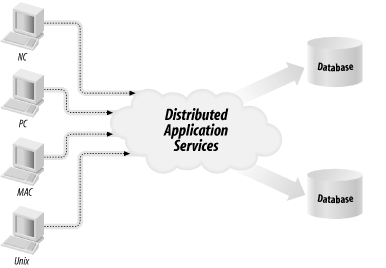Distributed Application Architecture
The distributed application architecture provides a place where application logic is supposed to occur. Figure 8-3 shows the layout of an application under the distributed application architecture.
 |
As you can see, this architecture is basically the client/server architecture with a special place for application logic—the middle tier. This small difference, however, represents a major philosophical shift from the client/server design. It says, in short, that it is important to separate application logic from other kinds of logic.
In fact, placing application logic in the database or in the UI hinders your application’s ability to grow with changing demands. If, for example, you need a simple change to your data model, you will have to make significant changes to your stored procedures if your application logic is in the database. A change to application logic in the UI, on the other hand, forces you to touch the UI code as well and thus risk adding bugs to systems that have nothing to do with the changes you are introducing.
The distributed application architecture does two things. It provides a home for application processing so that it does not get mixed in with database or UI code. However, it also makes the UI independent of the underlying data model. Under this architecture, changes to the ...
Get Managing & Using MySQL, 2nd Edition now with the O’Reilly learning platform.
O’Reilly members experience books, live events, courses curated by job role, and more from O’Reilly and nearly 200 top publishers.

